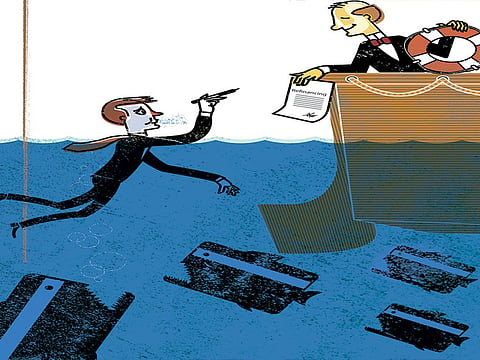An exit route from mounting credit card bills
Refinancing at much lower interest rates is still an option for the hard pressed

It would be wise to consider better financial planning as one of the New Year resolutions. In the aftermath of the financial crisis, it was evident that an individual could not only borrow easily, but could borrow a lot.
As individuals were being imprisoned, legal loopholes were exposed, one of which was the debt-to-salary ratio (DSR) which required an immediate fixing. And indeed it happened.
As the UAE Central Bank enhanced its control and oversight by having a better interlinking between banks and customers’ profiles, applying a maximum of 50 per cent on the debt-to-salary ratio (DSR) was made possible. Did this fix the issue and prevent individuals from accumulating huge debts?
Not really. This article focuses on how credit cards provide a way around the 50 per cent DSR, and how as an individual you can elevate your financial situation.
Whether before or after the 50 per cent DSR was imposed, the issue was, and probably still is, when individuals got their credit cards) from banks other than the ones where their salaries get credited. Irrespective of whether the individual has any type of loan or not, the other bank will hand over the credit card as long as the person signs out a check securing the full limit plus a percentage and as long as bank statements do not show regular monthly payouts.
Then, when the same individual applies for a credit fard from the same bank where the salary is credited, which wasn’t previously done, a bank’s employee will calculate what gets deducted on a monthly basis from the account. And guess what? The payments towards settling the balance of the other credit card won’t show in the statements, and the individual will be able to get new credit cards from their bank as long as its 5 per cent payment, added to other loan payments, do not exceed the 50 per cent DSR.
So in conclusion, you can get away with more than 50 per cent DSR.
A quick fix wouldn’t be to stop banks from handing over credit cards to customers of other banks, because as explained above, there is a way around it. A better way to do it would be to ensure that banks giving CCs to other banks’ customers would ask for a three-month bank statement each year to make sure that any individual is not taking on too much debt and is going unnoticed.
This might not have skipped bankers’ minds, but we sometimes choose to ignore what we don’t want to know. Then, if one is exposed to more debt than they are supposed to carry — especially with credit cards where annual interest rates can be anywhere from 20-36 per cent — what should be done instead of getting bailed out? Re-finance.
The UAE Central Bank introduced in 2014 that any new liability certificate being printed by an individual’s bank should be printed without the total interest, or profit in the case of Islamic financing, i.e., only the principal amount of the loan.
Then what you need to do is seek an interest rate, or profit rate, lower than the rate for which the financing has been provided by your bank. This makes sense for a personal or car loan, but why a credit card?
Well, and regardless of what limit you got on that credit card, as long as you can’t settle the balance fully, you are accruing too much interest because the monthly rate can range from 2-3 per cent (24-36 per cent annually) when you can get all of your liabilities refinanced for as low as 2.7 per cent annually.
If your current scenario doesn’t enable you to do proper financial planning, this is one way to extend the number of years for a lower monthly payout. It is then your task to improve your saving rate, reduce expenses wherever possible, and seek a better job or income in two or three years’ time.
The last thought that I want to leave you with is: why isn’t anyone paying attention to the credit cards’ bubble?
The writer is a commercial consultant and a commentator on economic affairs. You can follow him on Twitter at www.twitter.com/aj_alshaali
Sign up for the Daily Briefing
Get the latest news and updates straight to your inbox



